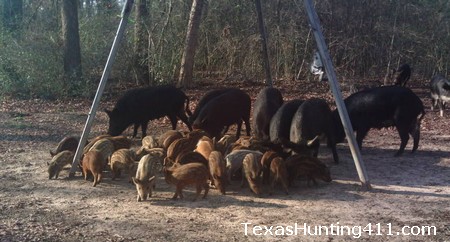Investigating New Ways to Control Feral Pigs
by Justin Foster, Texas Parks & Wildlife Department (TPWD)
originally published in TPWD “The Cedar Post” November 2013, Volume 3, Issue 2
It is probably no surprise to you that Kerr Wildlife Management Area (WMA) staff is involved in ongoing investigations to develop new tools for feral pig control. Rather than spending too much time justifying these efforts, I will summarize by saying that Kerr WMA staff and our chain of command believe: 1) Feral pigs pose significant danger to human health through transmission of disease; 2) Feral pigs are a threat to our native flora and fauna; 3) Feral pigs are a threat to our livestock markets and economy; and 4) Controlling feral pigs is very costly.
Although I am speaking of North America here, the case is very similar across the globe. Because TPWD’s WMA system is the research and demonstration arm of the Wildlife Division, it only makes sense that we focus our efforts and resources on an issue that is so important to many of you.

Our current goal is developing a tool(s) that reduce the cost of controlling pigs on your property. Our primary objective is to develop and register a toxic bait and delivery system with the United States Environmental Protection Agency that is feasible, user friendly, and environmentally safe. The golden goose egg here is to develop a product that can be a cost-effective way to reduce pig numbers without having negative impacts on the resources that all native Texans cherish.
Our current investigations are centered on sodium nitrite (not sodium nitrate). Sodium nitrite (NaNO2) is an inorganic compound that is commonly used in medicine, the food industry, and industrial chemistry. It affects our lives frequently as it is one of the most common food additives used for preserving meats. If you eat bacon, jerky, or cured meats, you are almost undoubtedly eating NaNO2. Don’t worry; the miniscule amount you consume could never have the acute effects upon you that intended doses can have on pigs. In fact, the bacon you consume will have more NaNO2 in it than the meat from a pig that is killed by sodium nitrite intoxication.
Sodium nitrite shows potential because: 1) its effect is rapid, lethal, and clinically humane in pigs; 2) it is readily available; 3) it is inexpensive; 4) there is an antidote (i.e. methylene blue); 5) user hazards are manageable; and 6) delivery can be environ-mentally safe. In a nutshell, sodium nitrite has the potential for safe and effective control of feral pigs.
The drawbacks to sodium nitrite for feral hog control are that it is highly unpalatable to pigs and it is also very unstable which means it can potentially react with bait ingredients. Such reactions not only reduce the potency of NaNO2, but may also breakdown to more noxious products causing pigs to reject it. This reactivity prevents any chance of creating an effective nitrite based bait in the barn at home. Whether rejection or potency, do it yourself chemistry is undoubtedly going to result in product that is not lethal to pigs. However, it is possible that a commercially produced bait could be available for the control of feral hogs in the not to distant future.